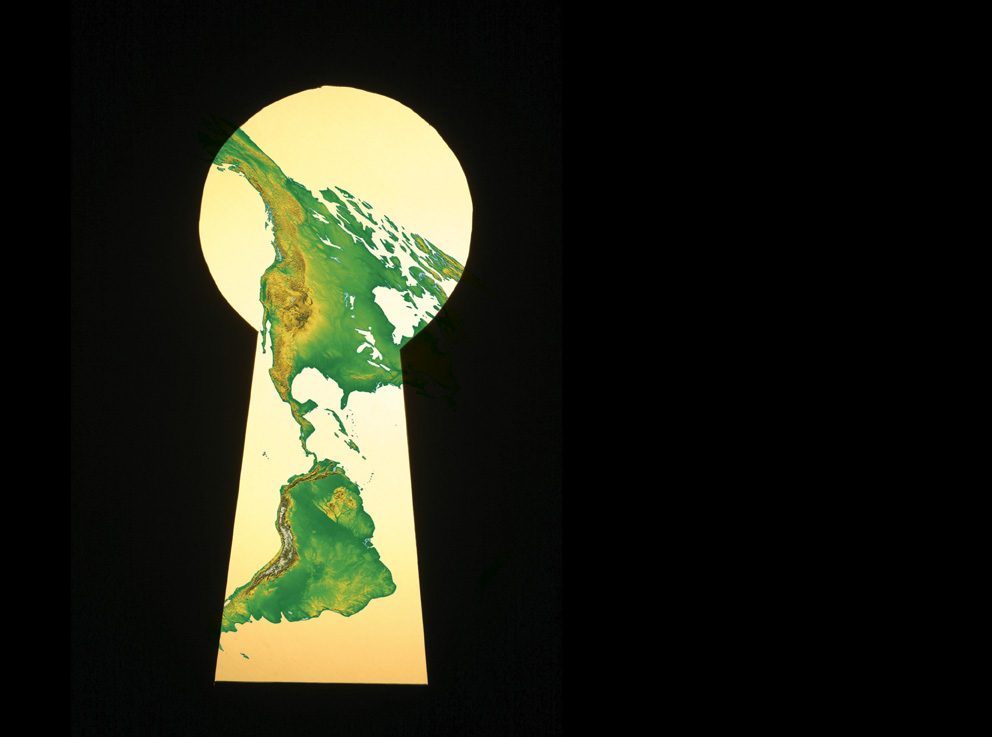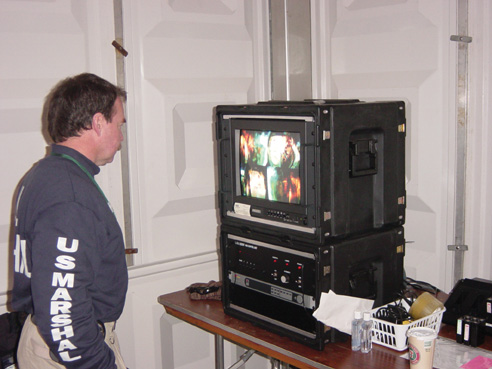By Ann-Marie Fleming
|

|
|
Securing ports and borders has become a major focus of U.S. Homeland Security. |
Securing ports and borders has become a major focus of Homeland Security, in particular since the events of 9/11. President George W. Bush has made addressing problems with illegal immigration, terrorist activities, and illegal smuggling of weapons and drugs a high level priority of border and port security. In October, 2005, the President signed the Department of Homeland Security Appropriations Act for 2006, which allocates US$30.8 billion in discretionary funding for the 2006 fiscal year. The bill apportions US$7.5 billion towards illegal immigration and gives US$139 million towards the improvement of border technology and intelligence capabilities to include cameras and sensors among others.
Homeland Security has worked to leverage the collective energy, ideas and commitment of all U.S. citizens. On Dec. 8, 2005, it announced it had brought the following agencies under its roof: The U.S. Customs Service (Treasury), the Immigration and Naturalization Service, The Federal Protective Service, the Transportation Security Administration and the Immigration and Naturalization Service, among others.
Homeland Security Secretary Michael Chertoff stated before the US. Senate Judiciary Committee, "President Bush has placed ever-increasing importance on border security and has devoted significant resources to this challenge. The President believes -- and I agree -- that illegal immigration threatens our communities and our national security. The ability of undocumented individuals to enter our country represents an obvious homeland security threat. Flagrant violation of our borders undercuts the rule of law, undermines our security, and imposes particular economic strains on our border communities. When we do not control our borders, we also risk entry into the U.S. of terrorists or others wishing to do us harm."
RFID BIOMETRIC CONVERGENCE?
A key initiative towards the achievement of secure borders and ports to ensure the facilitation of lawful travel and trade, an accurate immigration system and the overall protection of visitors and citizens is the U.S. Visit program. Under this program, foreign visitors are required to have their index fingers scanned as well as a digital photograph taken for travel document identification matching purposes. According to the Department of Homeland Security (DHS), US-VISIT entry procedures are in place at 115 airports, 15 seaports and can be found in secondary inspection areas in 154 land ports of entry, with exit procedures being utilized at 12 airports and two seaports.
Under the Visa Waiver Program, 27 nations, such as Australia, Austria, Norway, Belgium, Japan, the United Kingdom, France and Germany, had to meet a congressional mandate that required, as a first stage in the multi-stage border and port security strategy, that passports have digital photographs in passports by October 26, 2005. The next step, according to DHS, is a policy requiring these countries to produce e-passports which entails an RFID chip for storing biographic information, a digital photograph and other biometric details to be integrated into passports by the October 26, 2006, deadline.
This technology, under the U.S. Visit Program, allows for faster and more secure identification of illegal activity, and provides for more efficient border and port travel for visitors to the United States, while increasing the ability to share information among federal, state, local and foreign agencies. Its most practical aspects include fingerprint recognition, facial recognition, iris recognition, and hand geometry.
Homeland security technology expert Brian Ruttenbur, Equity Research Analyst, Morgan Keegan & Co. explains, "That really pushes countries and government officials to move are mandates with deadlines and funding attached to those. The US Visit has really pushed that along in enforcing the requirements set forth in the program in terms of biometric authentication, and governments have found the funding for those types of issues."
Sense Holdings, a provider of biometric and micro-sensor identification systems that target the homeland security market, sees the convergence of RFID and biometric technology as an effective security solution. The companys CEO, Dore Perler explains, "The use of RFID and biometric technologies is almost a perfect fit in the development of an easy-to-use intuitive security system. As a layered approach, the RFID requires little or no action from the end user, leaving only the biometric component. Essentially this doubles the security of the system without requiring any additional effort from the end user. Incorporating multiple RFID triggers facilities notification to the end user that they are not authorized prior to using the biometric or approaching the system terminal, thus minimizing the wear and tear on the biometric while correspondingly allowing the process to proceed faster for those authorized."
OPPORTUNITIES
"The biometric side of the business is going to grow extremely fast all because of the enhanced border and visa security act that was passed in 2002 by Congress, which is forcing every country in the entire world to go with biometric sensors and biometric travel documents. I see the EU Visitor Information System and UK e-borders spurring into multiple programs and there is going to be biometrics on every travel documents in five to ten years down the road and thats going to be National ID Cards, Visas, and Passports all with biometrics. The U.S. will be one of the last nations of the first world countries, to adopt a biometrics national ID card," Ruttenbur said.
Two key goals for the integration of biometric and RFID technology in terms of border and port security entail both accuracy as well as efficiency to help facilitate faster border crossing with an increased level of security. "The competitive advantage of implementing a technology-based solution, such as RFID, biometrics, or a combination, comes not from the technology itself, but from the improvements to business processes that would be impossible without the devices. We are very excited about the future of RFID integration with biometrics and as a stand-alone technology. Issues that have plagued industry are now able to be resolved with the incorporation of wireless LANs, RFID, and biometrics. Sense is positioning itself and developing new product lines to address these long time burdens," stated Perler.
SURVEILLANCE SYSTEMS
|

|
|
Under Vehicle Inspection System views the underside of vehicles entering and exiting secure areas/facilities for explosive devices and contraband. (Photo by Law Enforcement Associates) |
The tragic events that took place in London with the bombings within a major transit system have placed a growing sense of urgency on the need for effective surveillance technology. As Ruttenbur said, "I think that the next step to see across the borders will be camera systems getting rolled out. We have seen a number of announcements from the New York Transit Authority, the New Jersey Transit authority that they are starting to implement camera systems that monitor the platforms, trains, buses, etc."
According to Corby Lawrence, Director of Business Development for SYColeman, a division of L-3 Communications, "The roll-out of such camera systems must be planned, built, and implemented with a major focus on real-world operational effectiveness. Simply installing huge volumes of cameras and sensors and displaying the information on dozens of CCTVs exceeds the human capacity to detect threat activities within an area of concern."
L-3 Communications has addressed this global problem with its PRAETORIAN surveillance software. Created by Sarnoff Laboratories and recently purchased and commercialized by L-3, PRAETORIAN is the industrys only surveillance system capable of integrating multiple cameras and sensors into a single, 3D game-like display, permitting fly-through abilities.
As the war on terrorism across the globe expands, and public and private homeland security and related funding increase, the demand for surveillance is anticipated to continue its growth. Law Enforcement Associates (LEA) is working to take advantage of the intensified need for surveillance technology through the companys Under Vehicle Inspection System. As described by the company, the Under Vehicle Inspection System views the underside of vehicles entering and exiting secure areas/facilities for explosive devices and contraband. It is deployed on military bases, oil refineries, ports, United Nations and NATO Locations, embassies, nuclear facilities, and government installations. Paul Feldman, LEAs CEO, reveals, "Providing the needed security at border entry points and ports is a very tasking job. Our borders are vast and are difficult to fully monitor. The amount of freight that comes into our seaports is staggering. LEA has proven that their security products can play be an important part of the "overall security" plan to help in border and port security."
SENSOR TECHNOLOGY
The focus on sensor technology with applications in border and port security is increasing. Ruttenbur forecasts growth in sensor programs for cargo screening, which are just starting to emerge, as well as rollouts in the next several months for additional sensor programs that entail body scanners first in airports, then in other locations.
Sense Holdings is currently developing explosives sensor technology based on Micro Electro-Mechanical Sensors (MEMS) with plans on integrating this technology with biometric identification. "As the needs for Homeland Security escalate and become more complicated, there is a growing demand for innovative detection technology to ensure and enable security on a variety of levels. Along with developing technology that can accurately identify explosives and harmful material, the use of this technology must also be secured. The integration of biometric identification with effective explosives detection ensures that the activities are monitored, tracked and that the technology is only being used by authorized personnel, while at the same time helping to facilitate secure communication of sensor activity," said Perler.
Law Enforcement Associates has entered the detection market with its explosives detection kit, the EDK123. According to the company, it provides a fast, reliable field test for detection of trace nitrates that are found in 85 percent of all explosives, including TNT, Dynamite, Sentex, RDX and ammonium nitrates. It is currently being used by U.S. troops in Afghanistan and Iraq.
GLOBAL SECURITY
As the United States works towards a practical security plan to protect its borders and ports, it is becoming clear that homeland security is more accurately defined as Global Security. With the continuation of worldwide terrorist activity, it means that security can no longer be understood and evaluated in a domestic context alone. With a global perspective on security and the potential threats that we face, innovative and effective technology can be more clearly identified to address the needs for securing travel and trade. This focus points towards an industry that will continue to grow; one that will be here for the long run as it continues to evolve to meet the diverse challenges that global security demands.
Ann-Marie Fleming is staff writer of www.BorderandPortSecurity.com and www.HomelandDefenseStocks.com.
For more information, please send your e-mails to swm@infothe.com.
ⓒ2007 www.SecurityWorldMag.com. All rights reserved.
|



